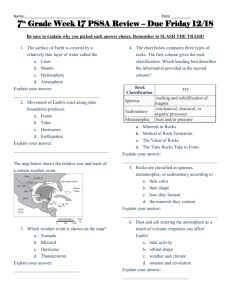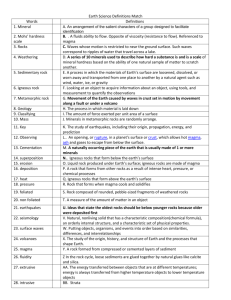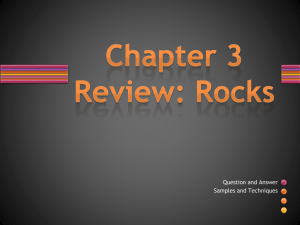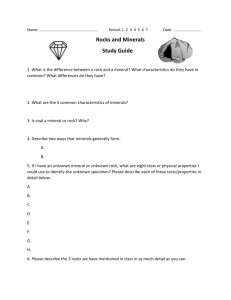File - Ms. D. Science CGPA
advertisement
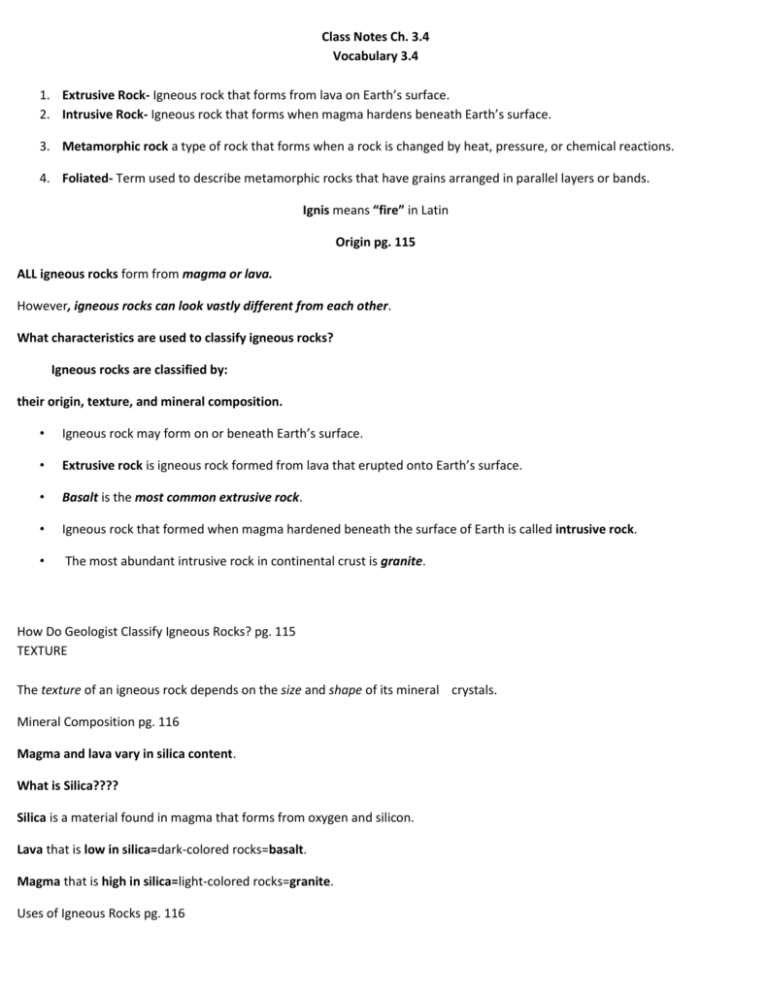
Class Notes Ch. 3.4 Vocabulary 3.4 1. Extrusive Rock- Igneous rock that forms from lava on Earth’s surface. 2. Intrusive Rock- Igneous rock that forms when magma hardens beneath Earth’s surface. 3. Metamorphic rock a type of rock that forms when a rock is changed by heat, pressure, or chemical reactions. 4. Foliated- Term used to describe metamorphic rocks that have grains arranged in parallel layers or bands. Ignis means “fire” in Latin Origin pg. 115 ALL igneous rocks form from magma or lava. However, igneous rocks can look vastly different from each other. What characteristics are used to classify igneous rocks? Igneous rocks are classified by: their origin, texture, and mineral composition. • Igneous rock may form on or beneath Earth’s surface. • Extrusive rock is igneous rock formed from lava that erupted onto Earth’s surface. • Basalt is the most common extrusive rock. • Igneous rock that formed when magma hardened beneath the surface of Earth is called intrusive rock. • The most abundant intrusive rock in continental crust is granite. How Do Geologist Classify Igneous Rocks? pg. 115 TEXTURE The texture of an igneous rock depends on the size and shape of its mineral crystals. Mineral Composition pg. 116 Magma and lava vary in silica content. What is Silica???? Silica is a material found in magma that forms from oxygen and silicon. Lava that is low in silica=dark-colored rocks=basalt. Magma that is high in silica=light-colored rocks=granite. Uses of Igneous Rocks pg. 116 • People throughout history have used igneous rock for tools and building materials because they are hard, dense, and durable. • Granite has been used to build statues, fortresses, bridges, and public buildings. • Today, thin polished sheets of granite are used in curbstones and floors. • Basalt is used for cobblestones and as a material in landscaping and roads. How are Metamorphic Rocks Classified? Pg. 116 What Are Metamorphic Rocks? Pg. 117 Metamorphic rock can form out of igneous, sedimentary, or other met. rock. Metamorphic rock= great heat, pressure=change in shape & composition When great heat and pressure are applied to rock, the rock can change both its shape and its composition Any rock that forms from another rock as a result of changes in heat or pressure (or both heat and pressure) is a metamorphic rock. Many Met. Rocks are found in mts. or near large masses of igneous rocks. WHY??? How Metamorphic Rocks Form? Pg. 114 Pockets of magma can rise through the crust. The high temperatures of these pockets can change rock into metamorphic rock. Collisions between Earth’s plates can also push rock down toward the heat of the mantle. Plate collisions cause great pressure to be applied to rock while mountains are being formed. The pressure can deform, change the physical shape of, the rock. Under very high temperature or pressure(or both) the minerals in a rock can be changed into other minerals. The appearance, texture and crystal structure of the minerals in the rock change. How are Metamorphic Rocks Classified? Pg. 118 Geologists classify metamorphic rocks according to the arrangement of the grains making up the rocks. Metamorphic rocks that have their grains arranged either in parallel layers or bands are said to be foliated. Foliated describes the thin, flat layering found in most metamorphic rocks. Crystals in granite can be flattened to create the foliated texture of gneiss. Heat and pressure change the sedimentary rock shale into slate. As shale changes into slate, the mineral composition of the shale can change. How Metamorphic Rocks Are Used Some metamorphic rocks are nonfoliated. The mineral grains in these rocks are arranged randomly. • Marble and quartzite are metamorphic rocks that have a nonfoliated texture. Quartzite forms out of quartz sandstone. Marble usually forms when limestone is subjected to heat and pressure deep beneath the surface. How Metamorphic Rocks Are Used pg. 119 Terrace of Ca d’Zan Sarasota Florida



